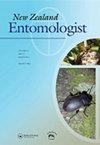在奥塔哥东南部一个关闭的煤矿的丛林残余物中的鞘翅目物种
IF 0.4
4区 农林科学
Q4 ENTOMOLOGY
引用次数: 1
摘要
修复土方工程和现场重建从根本上改变了奥塔哥东南部一个关闭煤矿的废弃性质。约90%的天然植被已被清除,取而代之的是大量种植本地灌木。一个由mānuka和kānuka灌木斑块组成的小网络(40多年前)被保留下来,作为清理后的光秃秃地面上的残余“岛屿”。2003年,对三个大小级别的灌木残体和一个成熟森林残体进行了鞘翅目取样,以确定哪些本土物种在修改后的环境中持续存在。72份样本共记录到24科81种1155只。除了没有大型掠食性物种外,本地物种在取样动物群中占主导地位,并被发现代表了典型的南奥塔哥森林相关组合。基于相对丰度的物种组成在不同残体大小群之间存在显著的多变量差异。只有6%的物种分布在所有的灌木遗迹中。后来在2010年从废弃岩石上7年的植物中采集的样本表明,与附近的mānuka-kānuka残留物几乎没有共同的物种。随着恢复时间的推移,一个结构良好的鞘翅目群落在煤矿植被恢复的栖息地中逐渐形成。本文章由计算机程序翻译,如有差异,请以英文原文为准。
Coleoptera species in bush remnants at a closed coal mine in southeast Otago
Rehabilitation earthworks and site reconstruction radically changed the abandoned nature of a closed coal mine in southeast Otago. Around 90% of natural vegetation was cleared for replacement mass planting of indigenous shrubs. A small network of mānuka and kānuka bush patches (40+ years old) was retained as remnant ‘islands’ in a matrix of cleared, bare ground. Coleoptera were sampled in three size classes of bush remnants and a mature forest remnant in 2003 to identify which indigenous species had persisted in the modified setting. From 72 samples, 1155 individuals were recorded from 81 species and 24 families. Indigenous species dominated the sampled fauna and, except for the absence of large predatory species, were found to represent a typical southern Otago forest-associated assemblage. Significant multivariate differences in species composition based on relative abundance existed between different remnant size groups. Only 6% of species were distributed throughout all of the bush remnants. A later sample taken in 2010 from 7-year-old plantings on waste rock indicated few shared species with the nearby mānuka–kānuka remnants. Over rehabilitation time, a finely structured Coleoptera community is developing in revegetated habitats at the coal mine.
求助全文
通过发布文献求助,成功后即可免费获取论文全文。
去求助
来源期刊

New Zealand Entomologist
ENTOMOLOGY-
CiteScore
0.70
自引率
33.30%
发文量
3
审稿时长
>12 weeks
期刊介绍:
The invertebrate diversity of New Zealand is of great interest worldwide because of its geographic isolation and geological history. The New Zealand Entomologist plays an important role in disseminating information on field-based, experimental, and theoretical research.
The New Zealand Entomologist publishes original research papers, review papers and short communications. We welcome submissions in all aspects of science regarding insects and arthropods in a New Zealand or Australasian setting. The journal’s subject matter encompasses taxonomy, phylogenetics, biogeography, biological control and pest management, conservation, ecology and natural history.
The journal is the official publication of the Entomological Society of New Zealand. Papers published or submitted elsewhere for publication will not be considered, but publication of an abstract or summary elsewhere (e.g. conference proceedings) does not preclude full publication in the New Zealand Entomologist. Accepted papers become copyright of the Entomological Society of New Zealand. The journal is published in English, but we also welcome publication of abstracts in Maori.
 求助内容:
求助内容: 应助结果提醒方式:
应助结果提醒方式:


